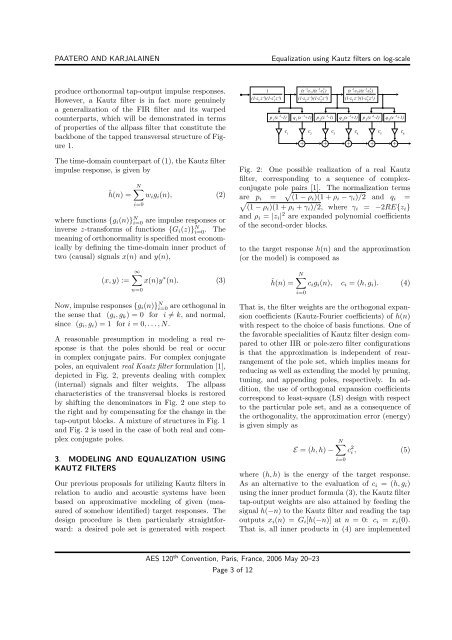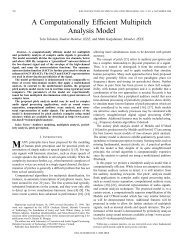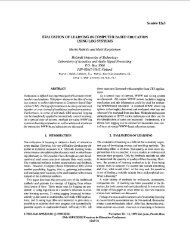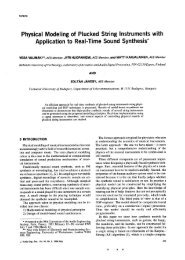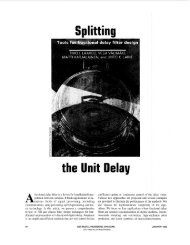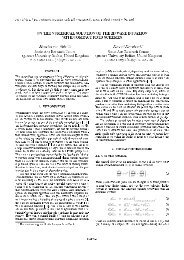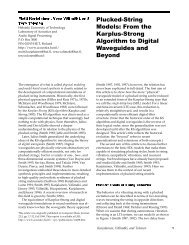Equalization of Audio Systems using Kautz Filters ... - TKK Acoustics
Equalization of Audio Systems using Kautz Filters ... - TKK Acoustics
Equalization of Audio Systems using Kautz Filters ... - TKK Acoustics
Create successful ePaper yourself
Turn your PDF publications into a flip-book with our unique Google optimized e-Paper software.
PAATERO AND KARJALAINEN<strong>Equalization</strong> <strong>using</strong> <strong>Kautz</strong> filters on log-scaleproduce orthonormal tap-output impulse responses.However, a <strong>Kautz</strong> filter is in fact more genuinelya generalization <strong>of</strong> the FIR filter and its warpedcounterparts, which will be demonstrated in terms<strong>of</strong> properties <strong>of</strong> the allpass filter that constitute thebackbone <strong>of</strong> the tapped transversal structure <strong>of</strong> Figure1.The time-domain counterpart <strong>of</strong> (1), the <strong>Kautz</strong> filterimpulse response, is given byĥ(n) =N∑w i g i (n), (2)i=0where functions {g i (n)} N i=0 are impulse responses orinverse z-transforms <strong>of</strong> functions {G i (z)} N i=0 . Themeaning <strong>of</strong> orthonormality is specified most economicallyby defining the time-domain inner product <strong>of</strong>two (causal) signals x(n) and y(n),(x, y) :=∞∑x(n)y ∗ (n). (3)n=0Now, impulse responses {g i (n)} N i=0 are orthogonal inthe sense that (g i , g k ) = 0 for i ≠ k, and normal,since (g i , g i ) = 1 for i = 0, . . . , N.A reasonable presumption in modeling a real responseis that the poles should be real or occurin complex conjugate pairs. For complex conjugatepoles, an equivalent real <strong>Kautz</strong> filter formulation [1],depicted in Fig. 2, prevents dealing with complex(internal) signals and filter weights. The allpasscharacteristics <strong>of</strong> the transversal blocks is restoredby shifting the denominators in Fig. 2 one step tothe right and by compensating for the change in thetap-output blocks. A mixture <strong>of</strong> structures in Fig. 1and Fig. 2 is used in the case <strong>of</strong> both real and complexconjugate poles.3. MODELING AND EQUALIZATION USINGKAUTZ FILTERSOur previous proposals for utilizing <strong>Kautz</strong> filters inrelation to audio and acoustic systems have beenbased on approximative modeling <strong>of</strong> given (measured<strong>of</strong> somehow identified) target responses. Thedesign procedure is then particularly straightforward:a desired pole set is generated with respectFig. 2: One possible realization <strong>of</strong> a real <strong>Kautz</strong>filter, corresponding to a sequence <strong>of</strong> complexconjugatepole pairs [1]. The normalization termsare p i = √ √(1 − ρ i )(1 + ρ i − γ i )/2 and q i =(1 − ρi )(1 + ρ i + γ i )/2, where γ i = −2RE{z i }and ρ i = |z i | 2 are expanded polynomial coefficients<strong>of</strong> the second-order blocks.to the target response h(n) and the approximation(or the model) is composed asĥ(n) =N∑c i g i (n), c i = (h, g i ). (4)i=0That is, the filter weights are the orthogonal expansioncoefficients (<strong>Kautz</strong>-Fourier coefficients) <strong>of</strong> h(n)with respect to the choice <strong>of</strong> basis functions. One <strong>of</strong>the favorable specialities <strong>of</strong> <strong>Kautz</strong> filter design comparedto other IIR or pole-zero filter configurationsis that the approximation is independent <strong>of</strong> rearrangement<strong>of</strong> the pole set, which implies means forreducing as well as extending the model by pruning,tuning, and appending poles, respectively. In addition,the use <strong>of</strong> orthogonal expansion coefficientscorrespond to least-square (LS) design with respectto the particular pole set, and as a consequence <strong>of</strong>the orthogonality, the approximation error (energy)is given simply asE = (h, h) −N∑c 2 i , (5)i=0where (h, h) is the energy <strong>of</strong> the target response.As an alternative to the evaluation <strong>of</strong> c i = (h, g i )<strong>using</strong> the inner product formula (3), the <strong>Kautz</strong> filtertap-output weights are also attained by feeding thesignal h(−n) to the <strong>Kautz</strong> filter and reading the tapoutputs x i (n) = G i [h(−n)] at n = 0: c i = x i (0).That is, all inner products in (4) are implementedAES 120 th Convention, Paris, France, 2006 May 20–23Page 3 <strong>of</strong> 12


